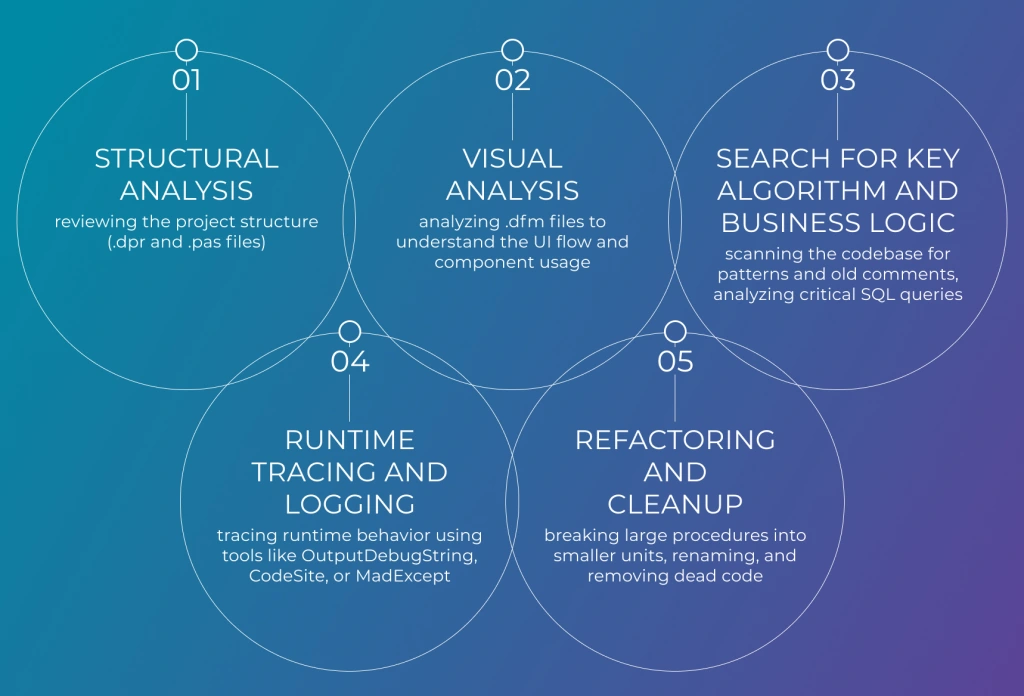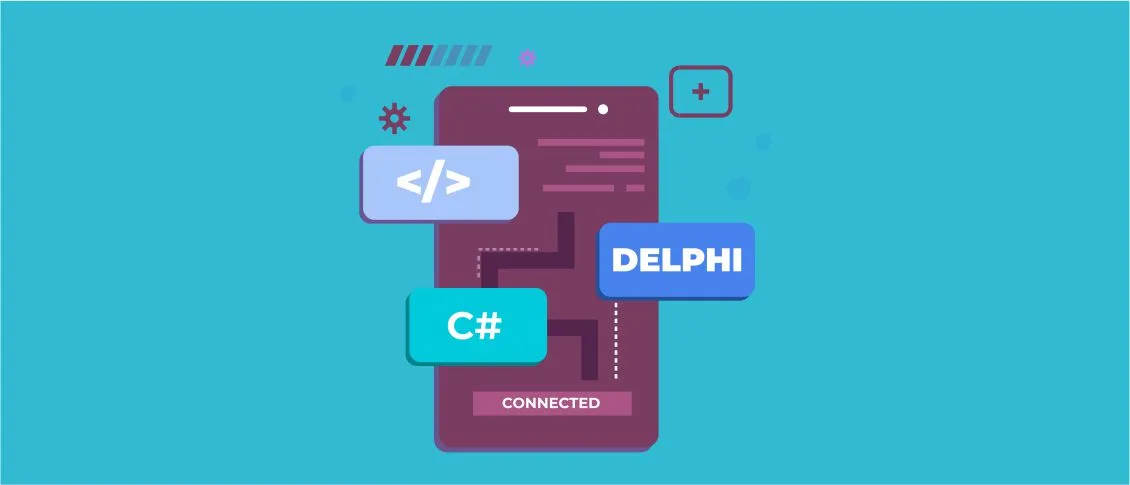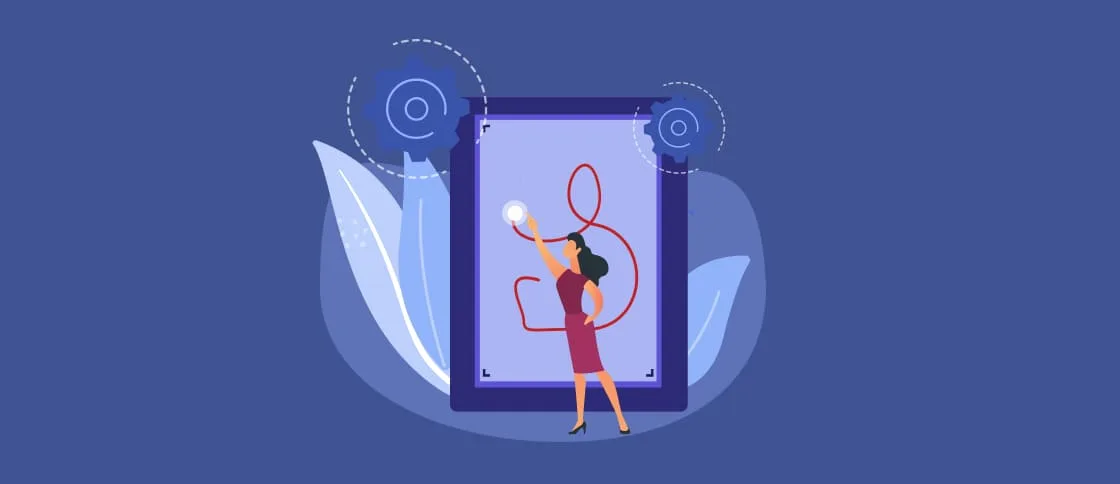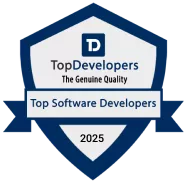- Introduction
- Outdated Components
- What does this mean for business?
- Softacom’s Approach
- Lost Knowledge
- What does this mean to the business?
- Real-World Snapshot: Modernization of ERP Software
- Softacom’s Approach
- Integration Nightmares
- What does this mean to the business?
- Softacom’s Approach
- Hidden Time Traps
- What does this mean for the business?
- Real-World Snapshot: Energy Sector · Industrial Measurement & Automation
- Softacom’s Approach
- Why Modernize?
- Ready to modernize without breaking what works?
- Get a free Delphi codebase assessment.
In this article, you’ll learn the key risks of Delphi modernization and how to spot them early, before they lead to downtime or budget overruns.
Prefer a more technical view? Check out the developer edition.
Main pitfalls include:
Introduction
Modernizing a Delphi system often feels like walking into a maze with no map. There’s no documentation. The only person who understood the logic retired years ago. And you’re staring at code full of outdated components and fragile integrations.
According to McKinsey, technical debt makes up ~40% of the average IT balance sheet. On top of every technology project, companies spend 10–20% more just to manage legacy issues – money that could fuel innovation but instead goes to patching the past. In fact, 30% of CIOs say over 20% of their IT budget is consumed by resolving tech debt.
At Softacom, we’ve seen it all. In 20+ years, we’ve worked with 125+ million lines of legacy Delphi code, from ANSI strings and BDE to Unicode, FireDAC, and 64-bit architecture. We’ve dealt with broken DevExpress styles, incompatible serialization and broken master-detail relationships in kbmMemTable, graphs breaking after migration with TeeChart.
In this guide, we have collected the most common issues that come up during Delphi modernization and what they mean for the business.
Outdated Components
Alex Azarou
Director of Information Technology“Every outdated component becomes a hidden liability. The more your system depends on it, the higher the cost when it fails.”
Delphi has thousands of third-party components, but not all are maintained, which might also cause a problem with licensing.
The deeper third-party components are embedded into the project, the higher the chance you’ll face compilation errors or unexpected behavior during migration. The most common issues include:
- Changes in internal component logic or behavior, including fixes or removed legacy features.
- Compilation breaks due to new packages, modules, data types, constants, procedures, or conditional compilation symbols introduced in newer versions.
These issues often surface in subtle ways, and the more your app relies on these components, the more time and care will be required to resolve them during migration.
What does this mean for business?
When third-party vendors stop supporting older Delphi IDEs, the cost shifts to your business.
- Developers spend days or weeks fixing bugs in abandoned components – time that could be used to release new features.
- Every urgent fix means lost productivity and higher maintenance costs. For a team of 5 developers, even 20% of time wasted on patching can equal $20K–$40K per month in lost value.
- Without vendor support, every upgrade or new data format requires custom fixes.
Business impact: Instead of investing in innovation, your IT budget is diverted into firefighting. Over the year, this can easily add up to hundreds of thousands of dollars in hidden costs.
Softacom’s Approach
We replace or refactor outdated components with modern, supported alternatives (e.g., FireDAC, UniDAC, TMS, LMD). This keeps your system maintainable and prevents hidden costs from escalating.
Lost Knowledge
Alex Azarou
Director of Information Technology“When no one remembers how the system works, modernization slows to a crawl – unless you combine automation with expert analysis to recover the logic.”
The original developers are gone. The documentation is outdated or missing. And now, you are left trying to modernize code you barely understand.
Business logic is often buried deep in forms, event handlers, and database queries, with no clear structure or explanation. Naming is often cryptic with unclear variable, constant, procedure, or data type names that make the code hard to follow.
In some cases, even SQL queries or arbitrary text strings are “encrypted” in ways that only the original developer understood. Some features exist simply because “it always worked that way.”
What does this mean to the business?
- Developers waste 20–40% of project time just trying to understand undocumented code.
- That can mean months of delays and hundreds of thousands in added costs.
- Without clear knowledge transfer, modernization projects risk failure.
This aligns with McKinsey’s findings: technical debt consumes 10–20% of every IT project’s budget and 40% of the IT balance sheet overall. Every undocumented process actively diverts money from innovation into maintenance.
Real-World Snapshot: Modernization of ERP Software
In one project, Softacom faced a 2.5M+ line Delphi XE4 system with almost no documentation. Normally, deciphering such a codebase would take months. But with Softacom’s AI-powered automation toolkit, we accelerated 30% of the migration tasks and delivered the project 3 months ahead of schedule.
Without automation and expert analysis, projects risk going over budget by 20–40% and missing market opportunities.
Softacom’s Approach

#1 Structural analysis – reviewing the project structure (.dpr and .pas files)
#2 Visual analysis – analyzing .dfm files to understand the UI flow and component usage
#3 Search for key algorithm and business logic – scanning the codebase for patterns like Save, Process, Calculate, or Execute, analyzing critical SQL queries, and searching for old comments.
#4 Runtime tracing and logging – tracing runtime behavior using tools like OutputDebugString, CodeSite, or MadExcept
#5 Refactoring and cleanup – breaking large procedures into smaller units, renaming variables, procedures, functions, constants, and data types, and removing dead code
Integration Nightmares
Alex Zdanovich
CTO“We still meet systems tied to outdated integrations that block connections with modern platforms and partners. Replacing them is less about code and more about untangling years of assumptions.”
Many Delphi systems still rely on SOAP, FTP, or DCOM. Migrating to REST, OAuth, or gRPC is rarely straightforward because legacy integrations are undocumented and tightly coupled.
What does this mean to the business?
- 95% of organizations report facing challenges with integration. Legacy systems make that worse by relying on outdated protocols.
- Outages, failed imports, or broken data flows can delay operations for days, frustrate employees, and disrupt customer services.
- The longer these integrations remain in place, the more expensive they become to replace and maintain.
Modernizing integrations not only reduces these risks but also opens doors to new platforms, partners, and revenue streams.
Softacom’s Approach
We analyze integration dependencies and design a step-by-step migration path, replacing outdated protocols while keeping the business running.
Hidden Time Traps
Serge Pilko
CEO“We’ve seen small technical gaps, like Unicode handling, cause months of delays and six-figure losses when discovered too late.”
Unicode bugs and 64-bit migration blockers are the silent killers of modernization projects. They don’t show up early, but once they surface, they derail timelines.
- String handling changes (ANSI → Unicode)
- Broken WinAPI calls
- Inline assembler incompatible with x64
- Structure alignment differences in 64-bit mode
What does this mean for the business?
If Unicode bugs or 64-bit blockers appear mid-migration, they can add 2–3 months of delays. For a typical enterprise team (5–7 developers, QA, and a project manager), that equals $100K+ in extra costs just in salaries and overhead, before counting lost revenue. Worse, the missed release of Windows can lead to lost contracts or churned clients. Identifying and fixing these traps early protects your ROI.
Moreover, developers report wasting 25% of their work effort dealing with technical debt. Again, time that could have been spent on innovation.
Real-World Snapshot: Energy Sector · Industrial Measurement & Automation
Delphi 7 to Delphi 12 with Linux Support
- Problem: Multilingual field reports were breaking due to ANSI strings.
- Challenge: App relied on BDE, Indy 9, and ran only on 32-bit Windows.
- Solution: Migrated to Delphi 12, FireDAC, and Indy 10; refactored WinAPI calls; added cross-platform support using FMX.
- Result:
✅Unicode-safe reports
✅Linux support
✅Zero support tickets after go-live
Softacom’s Approach
We audit code for Unicode and 64-bit readiness before migration starts. By fixing issues upfront, we protect your budget and timeline.
– Readiness check: Unicode & 64-bit blockers that derail timelines
– ROM estimates: timelines and budget corridors you can plan against
– Phased roadmap that keeps operations running during migration
Why Modernize?
Serge Pilko
CEO“For our clients, preserving business continuity is critical. That’s why we always connect every technical decision to its impact on timelines, budget and ROI.”
It is easy to see that modernization helps avoid the risks of software collapsing. But the real value is what your business gains once those risks are gone. But with modernization, businesses also get:
- Faster time-to-market. Cleaner architecture and reduced technical debt mean new features ship faster, giving you a competitive edge.
- Access to new platforms. Moving beyond Windows to Linux, cloud, or mobile environments expands your reach and customer base.
- Lower talent risk. Modern stacks are easier to hire for. Reducing reliance on legacy Delphi features cuts hiring costs and speeds up onboarding.
- Scalability for growth. Modern APIs and integrations open doors to new partner ecosystems, automation, and revenue streams.
- Innovation unlocked. Instead of spending 20-40% of your IT budget on maintaining legacy systems, those resources can be redirected into building products your customers actually want.
- Better user experience. Modernized systems are faster, more stable, and easier to use. That means fewer complaints, happier employees or customers, and higher retention.
Research from Red Hat shows that more than 50% of organizations see major improvements after modernization, including security (58%), scalability (53%), and reliability (52%). Nearly 98% of businesses report benefits in at least one critical area.
Ready to modernize without breaking what works?
Delphi modernization is rarely straightforward. Every system has its own hidden dependencies, outdated components, and undocumented logic. But you don’t have to navigate it alone.
At Softacom, we have modernized hundreds of Delphi applications across industries, from small utilities to 3-million-line enterprise systems. Our expertise covers mission-critical platforms such as ERP and financial systems, healthcare and production SaaS solutions, and security & surveillance software with computer vision modules. We know the common pitfalls, the rare edge cases, and the proven ways to overcome them.

Get a free Delphi codebase assessment.
Next steps:
- 30-minute audit to align goals and risks
- Quick code review. We check sample modules to spot risky components and blockers.
- Firm estimates & scope. You get timelines, budgets and a contractable scope you can rely on.
- Typical constraints we plan for: SLAs, release freeze windows and compliance.
Prefer a developer deep-dive? Get the Dev Edition.
Book your consultation. Let’s take a look together.






